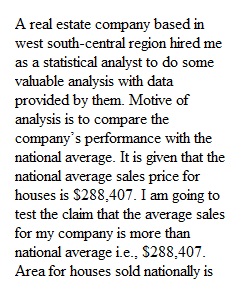


Q Competency In this project, you will demonstrate your mastery of the following competency: • Apply statistical techniques to address research problems • Perform hypothesis testing to address an authentic problem Overview In this project, you will apply inference methods for means to test your hypotheses about the housing sales market for a region of the United States. You will use appropriate sampling and statistical methods. Scenario You have been hired by your regional real estate company to determine if your region’s housing prices and housing square footage are significantly different from those of the national market. The regional sales director has three questions that they want to see addressed in the report:
Q 1. Are housing prices in your regional market higher than the national market average? 2. Is the square footage for homes in your region different than the average square footage for homes in the national market? 3. For your region, what is the range of values for the 95% confidence interval of square footage for homes in your market? You are given a real estate data set that has houses listed for every county in the United States. In addition, you have been given national statistics and graphs that show the national averages for housing prices and square footage. Your job is to analyze the data, complete the statistical analyses, and provide a report to the regional sales director. You will do so by completing the Project Two Template located in the What to Submit area below.
Q Directions Introduction 1. Purpose: What was the purpose of your analysis, and what is your approach? a. Define a random sample and two hypotheses (means) to analyze. 2. Sample: Define your sample. Take a random sample of 100 observations for your region. a. Describe what is included in your sample (i.e., states, region, years or months). 3. Questions and type of test: For your selected sample, define two hypothesis questions and the appropriate type of test hypothesis for each. Address the following for each hypothesis: a. Describe the population parameter for the variable you are analyzing. b. Describe your hypothesis in your own words. c. Describe the inference test you will use. i. Identify the test statistic. 4. Level of confidence: Discuss how you will use estimation and confidence intervals to help you solve the problem.
Q 1-Tail Test 1. Hypothesis: Define your hypothesis. a. Define the population parameter. b. Write null (Ho) and alternative (Ha) hypotheses. c. Specify your significance level. 2. Data analysis: Analyze the data and confirm assumptions have not been violated to complete this hypothesis test. a. Summarize your sample data using appropriate graphical displays and summary statistics. i. Provide at least one histogram of your sample data. ii. In a table, provide summary statistics including sample size, mean, median, and standard deviation. iii. Summarize your sample data, describing the center, spread, and shape in comparison to the national information. b. Check the conditions. i. Determine if the normal condition has been met. ii. Determine if there are any other conditions that you should check and whether they have been met. 3. Hypothesis test calculations: Complete hypothesis test calculations, providing the appropriate statistics and graphs. a. Calculate the hypothesis statistics. i. Determine the appropriate test statistic (t). ii. Calculate the probability (p value).
Q 4. Interpretation: Interpret your hypothesis test results using the p value method to reject or not reject the null hypothesis. a. Relate the p value and significance level. b. Make the correct decision (reject or fail to reject). c. Provide a conclusion in the context of your hypothesis. 2-Tail Test a. Hypotheses: Define your hypothesis. 1. Define the population parameter. 2. Write null and alternative hypotheses. 3. State your significance level. b. Data analysis: Analyze the data and confirm assumptions have not been violated to complete this hypothesis test. a. Summarize your sample data using appropriate graphical displays and summary statistics. i. Provide at least one histogram of your sample data. ii. In a table, provide summary statistics including sample size, mean, median, and standard deviation. iii. Summarize your sample data, describing the center, spread, and shape in comparison to the national information. b. Check the assumptions. i. Determine if the normal condition has been met. ii. Determine if there are any other conditions that should be checked on and whether they have been met. Hypothesis test calculations: Complete hypothesis test calculations, providing the appropriate statistics and graphs. . Calculate the hypothesis statistics. i. Determine the appropriate test statistic (t). ii. Determine the probability (p value). Interpretation: Interpret your hypothesis test results using the p value method to reject or not reject the null hypothesis. . Relate the p value and significance level. a. Make the correct decision (reject or fail to reject). b. Provide a conclusion in the context of your hypothesis. Comparison of the test results: See Question 3 from the Scenario section. . Calculate a 95% confidence interval. Show or describe your method of calculation. a. Interpret a 95% confidence interval.
Q Final Conclusions 1. Summarize your findings: Refer back to the Introduction section above and summarize your findings of the sample you selected. 2. Discuss: Discuss whether you were surprised by the findings. Why or why not?
View Related Questions